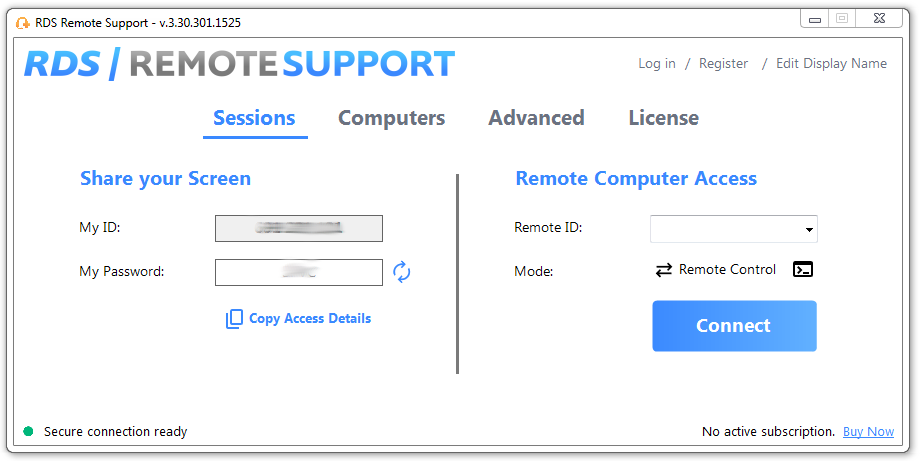Prerequisites
Before you begin the setup process, ensure that you have:
-
Installed Windows Server 2025 with the latest updates to enhance security and performance.
-
Administrator access on the server to perform configurations and installations.
-
Verified that your network settings are optimised for remote access.
Installing RDS Components
In short, the steps to follow take you from Server Manager, to add Roles and Features, to choosing the Installation Type and selecting the appropriate Server. If you have already done that, skip directly further down our article to “Configuring Remote Desktop or onward.
-
Access Server Manager
Start from the Dashboard to manage settings.
-
Add Roles and Features
Navigate through the wizard to select “Remote Desktop Services” installation. This step installs the necessary components and roles required for RDS.
-
Choose Installation Type
Opt for a 'Role-based' or 'Feature-based installation'. This allows you to install RDS roles on one or more servers, role-based being the option adapted for a single server deployment.
-
Select the Server
Choose the server from the server pool where you wish to install the RDS roles.
-
Select RDS Roles
You will then see a list of associated sub-roles, such as RD Connection Broker, RD Web Access, and RD Session Host, according to the specific purpose of the server.
-
Configure Role Services
Configuring each role according to your organizational needs might include SSL certificate configuration, load balancing, user permissions and RD Sessions Hosts security settings.
-
Confirm Installation Choices:
Reviewing all your selections correctly should include a thorough verification of dependencies. This is an essential stage to check you have considered and implemented everything.
-
Installation:
When proceeding with the installation, remember these matters take some time, depending amongst other factors on server performance and roles to be installed.
-
Post-Installation Configuration:
After installing RDS, additional configuration might be necessary, such as setting up the RD Gateway and configuring network policies. These steps ensure secure and functional access to your server resources via RDS.
Additional Tips
-
System Compatibility Check
Before initiating the installation, make sure your Windows Server 2025 is updated to the latest version to avoid compatibility issues.
-
Backup Your System
It's advisable to perform a system backup before installing significant roles like RDS to prevent data loss in case of installation failures.
-
Consult Documentation
Referring to Microsoft’s detailed RDS documentation can provide additional insights and best practices for complex set-ups.
Configuring Remote Desktop
-
Configure the Deployment Scenario
Decide whether to configure a session-based or a virtual machine-based deployment. For most applications, a session-based approach is adequate.
-
Publish Applications
Select applications you need available remotely and publish them through the Remote Desktop Services. This makes them accessible to users remotely.
-
Set User Permissions and Groups
Define which users or groups can access the Remote Desktop Sessions. Proper user management ensures that only authorised personnel can access your server remotely.
Securing RDS
Enhancing the security of your Remote Desktop setup is critical, all the more since RDS is known for its vulnerabilities.
-
Implement RDS Advanced Security
Make use of tools from RDS-Tools, such as Advanced Security, to
protect against cyber threats and unauthorized access
Read on below for more details on RDS Advanced Security features.
-
Network Level Authentication (NLA)
Always enable NLA for an additional layer of authentication before a session is established.
-
Configure Firewalls and Network Policies
Set strict rules to govern the access to the Remote Desktop, ensuring that only known and authorised IPs have access. You will find what you need amongst the features below.
Robust RDS Features from RDS Advanced Security
To bolster the security of Remote Desktop Services on Windows Server 2025, implement RDS Advanced Security. Indeed, our software offers a suite of sophisticated tools designed to protect against a wide range of cyber threats. Peruse some of the capabilities and benefits provided:
1. Geographic IP Restrictions:
Control access to your network based on geographic locations. This feature allows administrators to
block or allow
connections from specific countries, thus adding an important layer of security which prevents unauthorized access from high-risk areas.
2. Brute Force Attack Prevention:
RDS Advanced Security comes equipped with mechanisms to detect and thwart brute force attacks. By monitoring failed login attempts, the system can automatically lock out IP addresses which display suspicious activity, significantly reducing the risk of intrusion.
3. Session Recording:
For compliance and monitoring purposes, session recording is a critical feature. It allows for the capture of all session activity, providing an audit trail that can be reviewed for suspicious behaviour or used in forensic analysis after a security incident.
4. End-to-End Encryption:
To safeguard data integrity and privacy, RDS Advanced Security ensures that all data transmitted between the client and server is encrypted. Implementing robust encryption protocols, this feature ensures that sensitive information remains secure from eavesdropping and man-in-the-middle attacks.
5. Multi-Factor Authentication (MFA):
This security measure requires users to provide two or more sets of credentials to gain access to the RDS environment, adding an extra layer of security beyond just username and password.
These features of RDS Advanced Security ensure the efficiency of your deployment of Remote Desktop Services on Windows Server 2025. Moreover, they also secure your servers and network against evolving digital threats. By leveraging these advanced capabilities, organizations can protect their critical systems and data while maintaining a productive and accessible remote work environment.
Monitoring and Maintenance
Effective monitoring and regular maintenance are key to ensuring that your RDS environment runs smoothly:
-
Leverage RDS Server Monitoring
Use RDS-Tools to
monitor real-time performance
and user activities. Our tool helps in proactive management and troubleshooting of issues, as and when they arise.
-
Regular Updates and Security Patches
Keep your server updated with the latest Microsoft patches and updates. Such best practice is paramount since it not only enhances features but also fixes security vulnerabilities.
Enhancing RDS Server Monitoring Capabilities
As mentioned, you can further enhance the stability and efficiency of Windows Server 2025 through RDS Server Monitoring. Here is an in-depth look at features set to significantly improve your server management:
1. Advanced Analytics and Reporting:
RDS Server Monitoring includes tools which not only track real-time data but also analyse trends over time. Real-time data allows IT managers to understand usage patterns and system demands. These in turn inform capacity planning and resource allocation decisions.
Generate detailed reports to provide insights into performance bottlenecks, user behaviour and application efficiency. Sharing such knowledge and facts with appropriate teams means better company choices, network planning, commercial and strategic aspects and more.
2. Alert System:
The monitoring software can be configured to send automatic alerts in response to specific triggers, such as system overload, unexpected downtime or security threats. These alerts enable IT teams to respond immediately to potential issues before they affect the broader network.
3. Health Checks:
Regular health checks can be scheduled to assess the operational status of the RDS environment. These checks ensure that all components are functioning correctly and efficiently, helping to prevent service disruptions.
4. Resource Optimization:
By
monitoring resource utilisation
continuously, RDS Server Monitoring helps in identifying over- and under-utilised resources. This facilitates optimal resource distribution, enhancing the overall performance and reducing unnecessary costs.
5. Customizable Dashboards:
Customizable dashboards provide a user-friendly interface where key performance indicators (KPIs) can be monitored. This tailored view helps administrators keep an eye on the most critical metrics specific to their environment.
These enhanced features of RDS-Server Monitoring ensure that your Remote Desktop Services environment on Windows Server 2025 operates with maximum efficiency and reliability. By leveraging detailed analytics and proactive management tools, organisations can maintain high performance and quickly adapt to changing demands within their IT infrastructure.
Enhancing IT Support with RDS Remote Support
RDS Remote Support, designed specifically for Windows Server 2025 environments, delivers a suite of tools that streamline the process of
updating, troubleshooting and supporting
network and IT infrastructure efficiently. Here’s how RDS Remote Support enhances IT management:
1. Remote Assistance and Control:
Provides administrators and support teams with the capability to remotely access and control servers and user sessions. This is essential for diagnosing and resolving issues without the need for physical presence, leading to faster resolution times.
2. Session Shadowing:
This feature allows IT staff to join user sessions, offering direct assistance and troubleshooting support. It's particularly useful for guiding users through complex updates or resolving user-specific issues in real time.
3. Automated System Updates:
RDS Remote Support can automate the deployment of system updates and patches, ensuring that all devices within the network are up-to-date with the latest security patches and performance improvements. This automation reduces the workload on IT staff and enhances system security and stability.
4. Detailed Activity Logs:
Maintaining logs of all remote sessions is critical for audit trails and security. RDS Remote Support ensures that every intervention is logged with detailed reports on actions taken, providing transparency and aiding in compliance efforts.
5. Instant Alerts and Notifications:
RDS Remote Support can be configured to send instant alerts to administrators. Since relevant staff are notified when issues are detected, teams can immediately respond to potential problems. This proactive approach minimises downtime and ensures that services are restored quickly.
Incorporating RDS Remote Support into Windows Server 2025 environments not only simplifies the management of network and IT infrastructure but also enhances the effectiveness of support teams. By providing robust tools for remote management, automated updates and real-time troubleshooting, organizations can significantly improve operational efficiency and user satisfaction.
Troubleshooting Common Issues in Windows Server 2025
Address common problems
which might occur during the use of RDS with the help of RDS Tools:
-
Connection Troubleshooting
Check network settings, verify user permissions and ensure security settings are correctly configured if users report connection issues.
-
Performance Optimization
Adjust server configurations based on performance metrics. Utilize RDS-Tools to gain insights into resource usage and optimize accordingly.
Conclusion on How to Enable Remote Desktop Windows Server 2025
Enabling RDS on Windows Server 2025 allows MSPs and other IT professionals to maximize their operational efficiency by providing flexible and secure access to their network resources. By following the steps outlined in this guide, your network will fare all the better. Additionally, thanks to RDS-Tools, you can ensure that your RDS setup is both robust and secure, efficient and responsive.
ready to handle the demands of modern remote workflows
.
To join us and become an RDS-Tools partner, find out more here and discover how you can serve the IT community around you.
RDS Remote Support Free Trial
Cost-effective Attended and Unattended Remote Assistance from/to macOS and Windows PCs.




)



)
)
)
)
